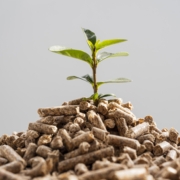Biomass energy: what it is, uses and benefits
In this article, I explain what biomass energy is, where it comes from, how it is converted into heat, electricity or biomethane, and what you need to get started.
What is biomass energy?
Biomass is organic matter of plant or animal origin (forestry and agricultural waste, industrial by-products, sludge, biowaste). Bioenergy is the energy obtained by converting this biomass into solid, liquid or gaseous fuels for heat, electricity or transport.
Why it matters today
In the EU, bioenergy (biomass energy) remains the largest renewable source, accounting for ~59% of renewable consumption in 2021. In 2023, renewables reached 24.5% of total EU energy consumption; biomass plays a key role in heating and cooling. European Commission
Types of biomass and practical examples
- Solid biomass: forest residues (branches, chips), agricultural residues (straw), wood and by-products (pellets).
- Biogas/biomethane: anaerobic digestion of agricultural and livestock waste, WWTP sludge and biowaste.
- Biofuels: used vegetable oils, bioethanol (agricultural waste) for transport.
Tip from Reverter Industries: if you work with wood and pruning waste, start by preparing the material with a good industrial shredder and a wood recycling line to achieve consistent size and quality.
How is biomass converted into energy?
- Preparation: crushing/chipping, drying and sorting to obtain a stable fuel (pellets, wood chips, wood shavings).
- Thermal conversion: biomass boilers for heat and DHW; electricity is also produced in cogeneration.
- Biological conversion: biogas via anaerobic digestion; upgrading allows biomethane to be injected into the grid or used in transport. irena.org
Useful standards: in Spain, the IDAE offers technical guides on thermal biomass and highlights eco-design requirements and UNE-EN 303-5 for solid fuel boilers. idae.es
Benefits (and limitations) of ‘biomass energy’
Advantages
- Decarbonisation: replaces fossil fuels in heating and thermal processes.
- Waste management: recycles forestry/agro-industrial waste.
- Local economy: rural employment and reduced dependence on external sources.
Challenges
- Resource sustainability (origin, traceability, competition for uses).
- Emissions and efficiency: suitable boilers and filters; correct design and operation.
- Logistics: humidity, density and seasonality. (IEA/IRENA detail sustainability and orderly scaling needs). IEA
Regulatory framework and sustainability criteria
- European Commission – Bioenergy: guidelines and sustainability criteria; biomass remains a renewable pillar. Energy
- Eurostat: evolution of renewables in the EU (2022–2023) and revised 2030 targets (42.5% with an aspiration of 45%). European Commission
- Spain: MITECO and IDAE publish definitions, guidelines and participatory processes on biomass and efficiency. idae.es
Recommended reading
- European Commission – Bioenergy/biomass (role and sustainability). Energy
- IEA Bioenergy – What is bioenergy? (definition and uses). ieabioenergy.com
- IRENA – Bioenergy for the energy transition (potential and sustainability). irena.org
- Eurostat – Renewables in the EU (2023/2024) (data and targets). European Commission
- IDAE – Biomass (definition and technical resources). idae.es
Conclusion
Biomass energy is a practical way to decarbonise heat and processes, recover waste and generate local impact. The key is to ensure the sustainability of the resource, prepare the fuel properly and comply with regulations. With the right design and reliable technical partners, you can reduce energy costs and your carbon footprint.






Leave a Reply
Want to join the discussion?Feel free to contribute!